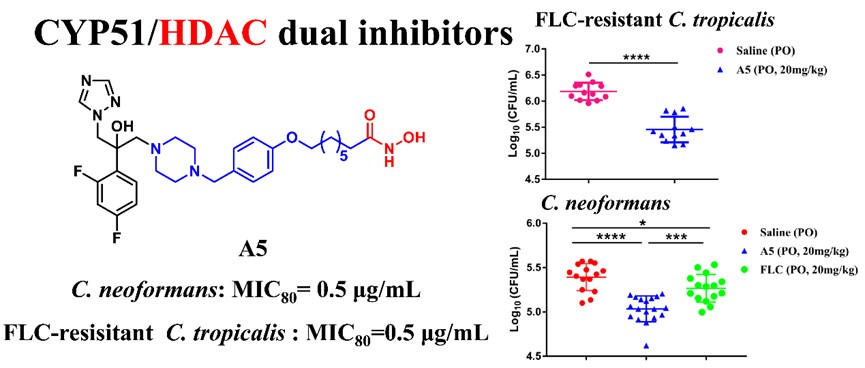Prof. Xu Defeng's Research Team Developed A New Series of CYP51/HDAC Dual Inhibitors for the Treatment of Drug-resistant Candida Tropicalis and Cryptococcus Neoformans Infections
发布时间: 2021-05-18 访问次数: 467
In recent years, the morbidity of invasive fungal infections (IFIs) has increased significantly. However, due to severe drug resistance and the types of clinically available azoles drugs, therapeutic effect of IFIs remains limited.At present, the mechanisms of azole drugs resistance mainly include overexpression of the target enzyme CYP51 and structural mutations of the target enzyme. In addition, HDAC inhibitors trichostatin A (TSA) and vorinostat (SAHA) synergized withazole drugs against azoles-resistant fungi have been reported.
Thus, the key pharmacophore fusion method was used by prof. Xu Defeng's team, and the CYP51/HDAC dual inhibitors were designed by fusing the triazole and phenyl group of the CYP51 inhibitor with the linker and ZBG group of HDAC inhibitor. Among them, the compound A5 treated group significantly reduced kidney fungal burden of mice, and its effect on reducing brain fungal burden was superior to FLC (Figure 1).

Figure 1
Fungal biofilms and hyphae are important virulence factors and are commonly seen in IFIS patients who have received in vivo implant therapy and indwelling catheter surgery. The studies have shown that the compound A5 significantly inhibited the production of virulence factor in drug-resistant Candida tropicalis and Cryptococcus neoformans (Figure 2).

Figure 2
The article was published in the European Journal of Medicinal Chemistry, Title: Lanosterol 14α-Demethylase (CYP51)/Histone Deacetylase (HDAC) Dual Inhibitors for Treatment of Candida tropicalis and Cryptococcus neoformans Infections. Zhu Tianbao, a 2018 master student of Changzhou university under the supervision of prof. Xu Defeng, is the first author of this paper. Prof. Xu Defeng from Chanzhou university, prof. Sheng Chunquan and associate prof. Liu Na from Naval Military Medical university are the co-corresponding authors of this paper. Changzhou university is the first communication author institution.